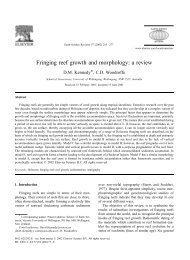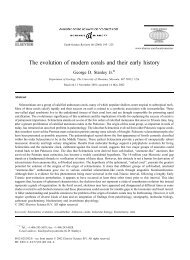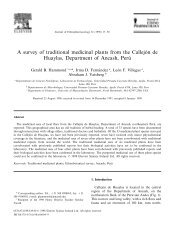Population status of the Orinico crododile in Venezuela
Population status of the Orinico crododile in Venezuela
Population status of the Orinico crododile in Venezuela
You also want an ePaper? Increase the reach of your titles
YUMPU automatically turns print PDFs into web optimized ePapers that Google loves.
354 A.E. Seijas, C. ChaÂvez / Biological Conservation 94 (2000) 353±361<br />
1940; Humboldt, 1975; Pa ez, 1980; Medem, 1981, 1983).<br />
The species also extended, although probably at low<br />
densities, well up many Llanos rivers and <strong>in</strong>to surround<strong>in</strong>g<br />
piedmont areas <strong>in</strong> <strong>the</strong> foothills <strong>of</strong> <strong>the</strong> Andes<br />
(Ramo and Busto, 1986; Thorbjarnarson and Herna ndez,<br />
1992), and most <strong>of</strong> <strong>the</strong> sou<strong>the</strong>rn bank tributaries <strong>of</strong> <strong>the</strong><br />
Or<strong>in</strong>oco <strong>in</strong>clud<strong>in</strong>g heavily forested regions (Hitchcock,<br />
1948; Franz et al., 1985).<br />
Currently, <strong>the</strong> most important, and probably only<br />
viable populations <strong>of</strong> <strong>the</strong> Or<strong>in</strong>oco crocodile (Arteaga et<br />
al., 1997), are found <strong>in</strong> two areas <strong>of</strong> contrast<strong>in</strong>g characteristics<br />
<strong>in</strong> <strong>Venezuela</strong>: (1) The Capanaparo river <strong>in</strong> <strong>the</strong><br />
state <strong>of</strong> Apure, a prime-quality habitat, impacted relatively<br />
little by human activities, <strong>in</strong> <strong>the</strong> center <strong>of</strong> <strong>the</strong> species'<br />
range and where it reached its historically highest<br />
densities, and (2) <strong>the</strong> Cojedes region, <strong>in</strong> <strong>the</strong> states <strong>of</strong><br />
Cojedes and Portuguesa, a system <strong>of</strong> narrow rivers, near<br />
<strong>the</strong> periphery <strong>of</strong> <strong>the</strong> distribution <strong>of</strong> <strong>the</strong> Or<strong>in</strong>oco crocodile<br />
and very close to some <strong>of</strong> <strong>the</strong> most important agricultural,<br />
urban and <strong>in</strong>dustrial centers <strong>in</strong> <strong>the</strong> country (Godshalk,<br />
1978, 1982; Ayarzaguena, 1987, 1990; Thorbjarnarson<br />
and Herna ndez, 1992, 1993a,b).<br />
In addition to its isolation from urban, agricultural<br />
and <strong>in</strong>dustrial centers, part <strong>of</strong> <strong>the</strong> Capanaparo River is<br />
currently protected as <strong>the</strong> Santos Luzardo National<br />
Park. This o€ers an umbrella <strong>of</strong> protection to its Or<strong>in</strong>oco<br />
crocodile population, an important, although not<br />
su cient, step toward <strong>the</strong> conservation <strong>of</strong> <strong>the</strong> species<br />
(Thorbjarnarson and Herna ndez, 1992, 1993a,b). No<br />
protected area exists <strong>in</strong> <strong>the</strong> Cojedes region, and <strong>the</strong><br />
Or<strong>in</strong>oco crocodile population <strong>in</strong> that river system is<br />
under strong anthropogenic pressure (Seijas, 1998).<br />
As <strong>the</strong> site <strong>of</strong> <strong>the</strong> largest known population <strong>of</strong> an<br />
endangered species, <strong>the</strong> CRS should be <strong>the</strong> focus <strong>of</strong> a<br />
major national conservation program. Careful and reliable<br />
monitor<strong>in</strong>g <strong>of</strong> crocodile populations is an essential<br />
requirement for implementation <strong>of</strong> a management program<br />
for its conservation. In this study we update <strong>the</strong><br />
population <strong>status</strong> <strong>of</strong> C. <strong>in</strong>termedius <strong>in</strong> <strong>the</strong> CRS and<br />
suggest ways to <strong>in</strong>crease <strong>the</strong> accuracy <strong>of</strong> population<br />
<strong>in</strong>dices by identify<strong>in</strong>g sources <strong>of</strong> variation that should<br />
be controlled when monitor<strong>in</strong>g trends <strong>in</strong> <strong>the</strong> future.<br />
2. The Cojedes River System<br />
For <strong>the</strong> purposes <strong>of</strong> this study, <strong>the</strong> Cojedes River<br />
System (CRS) is de®ned as <strong>the</strong> mid and lower portion <strong>of</strong><br />
<strong>the</strong> Turbio±Cojedes river bas<strong>in</strong>. It covers a wide fr<strong>in</strong>ge<br />
along <strong>the</strong> Cojedes and Sarare rivers <strong>in</strong> <strong>the</strong> states <strong>of</strong><br />
Cojedes and Portuguesa. The system encompasses <strong>the</strong><br />
cities <strong>of</strong> Acarigua and San Carlos to <strong>the</strong> north and<br />
extends sou<strong>the</strong>ast to <strong>the</strong> con¯uence <strong>of</strong> <strong>the</strong> ma<strong>in</strong> course<br />
<strong>of</strong> <strong>the</strong> Cojedes river with CanÄ o Amarillo-La Culebra<br />
near <strong>the</strong> town <strong>of</strong> El Bau l (Fig. 1). In <strong>the</strong> nor<strong>the</strong>rn part<br />
<strong>of</strong> <strong>the</strong> CRS, agricultural lands dom<strong>in</strong>ate <strong>the</strong> landscape<br />
and are <strong>in</strong>terspersed with large-and medium-sized urban<br />
centers and cattle ranches. The sou<strong>the</strong>rn part <strong>of</strong> <strong>the</strong><br />
region ( south <strong>of</strong> <strong>the</strong> Lagunitas-Santa Cruz road) is a<br />
matrix <strong>of</strong> forested savannas and cattle pastures <strong>in</strong>termixed<br />
with forest relicts, scattered agricultural lands,<br />
wetlands, and o<strong>the</strong>r less extensive land-cover categories.<br />
The CRS has zones <strong>of</strong> relatively high human population<br />
densities <strong>in</strong> <strong>the</strong> north, where <strong>the</strong> cities <strong>of</strong> San Carlos<br />
(>80,000 people) and Acarigua ( 200,000 people) are<br />
located and <strong>the</strong> rivers <strong>the</strong>re have been modi®ed by<br />
damm<strong>in</strong>g, channelization, dredg<strong>in</strong>g, contam<strong>in</strong>ation, and<br />
deforestation. In zones <strong>of</strong> low human population densities<br />
(<strong>in</strong> <strong>the</strong> south) no town larger than 6000 people<br />
exists and <strong>the</strong> rivers are more prist<strong>in</strong>e. In 1975, 33% <strong>of</strong><br />
<strong>the</strong> state <strong>of</strong> Cojedes was covered by forest. That percentage<br />
decreased to less than 16% <strong>in</strong> 1988. The annual<br />
rate <strong>of</strong> deforestation <strong>in</strong> <strong>the</strong> state <strong>of</strong> Cojedes (3.81%) is<br />
<strong>the</strong> second highest <strong>in</strong> <strong>the</strong> country, surpassed only by <strong>the</strong><br />
state <strong>of</strong> Portuguesa, its neighbor, with 4.08% per year<br />
(MARNR, 1995). No protected area or conservation<br />
reserve <strong>of</strong> any type exists with<strong>in</strong> <strong>the</strong> Cojedes River<br />
bas<strong>in</strong>.<br />
There are two clearly de®ned seasons <strong>in</strong> <strong>the</strong> CRS, as is<br />
typical <strong>of</strong> <strong>the</strong> Llanos region <strong>in</strong> <strong>Venezuela</strong>. The ra<strong>in</strong>y<br />
season extends from May to October, and <strong>the</strong> dry season<br />
from December to March. April and November are<br />
transitional months. The annual mean precipitation<br />
(1975±1996) is 1323 mm <strong>in</strong> <strong>the</strong> middle part <strong>of</strong> <strong>the</strong> study<br />
area (Fig. 2) and a little higher (1514 mm) toward <strong>the</strong><br />
south at El Bau l. Dur<strong>in</strong>g <strong>the</strong> ra<strong>in</strong>y season <strong>the</strong> river discharge<br />
<strong>in</strong>creases (Fig. 2) and frequently over¯ows its banks<br />
and <strong>in</strong>undates <strong>the</strong> ¯oodpla<strong>in</strong>, particularly <strong>in</strong> <strong>the</strong> sou<strong>the</strong>rn<br />
portion <strong>of</strong> <strong>the</strong> study area. The annual range between <strong>the</strong><br />
absolute m<strong>in</strong>imum and maximum temperatures is 11.6 C<br />
(21.7±33.3 C) (MARNR, 1995).<br />
3. Methods<br />
From 1991 to 1997, nocturnal spotlight surveys were<br />
carried out from a 3.7 m open boat powered by 10 or 15<br />
hp outboard eng<strong>in</strong>e. Most <strong>of</strong> <strong>the</strong> sampl<strong>in</strong>g was conducted<br />
along a section <strong>of</strong> <strong>the</strong> Cojedes River called CanÄ odeAgua,<br />
which was divided <strong>in</strong>to segments named CanÄ odeAgua<br />
Norte (CAN) and CanÄ o de Agua Sur (CAS)(<strong>the</strong> road<br />
between Lagunitas and Santa Cruz was <strong>the</strong> divid<strong>in</strong>g<br />
po<strong>in</strong>t). The segment <strong>of</strong> <strong>the</strong> river between Merecure and<br />
<strong>the</strong> fork <strong>of</strong> CanÄ o Amarillo (CAM) was also surveyed<br />
repeatedly. Less frequently visited were a short section<br />
<strong>of</strong> <strong>the</strong> Cojedes north <strong>of</strong> Apartaderos-San Rafael<br />
(Cojedes Norte, CON), <strong>the</strong> sou<strong>the</strong>rn segment near Sucre<br />
(SUC) and <strong>the</strong> lower portion <strong>of</strong> La Culebra (CUL).<br />
Sections <strong>of</strong> <strong>the</strong> Sarare River, <strong>the</strong> larger tributary <strong>of</strong> <strong>the</strong><br />
Cojedes River to <strong>the</strong> west, were also studied (SAR).<br />
Surveys were started between 1930 and 2000 hr. The<br />
direction <strong>of</strong> <strong>the</strong> survey was clockwise <strong>in</strong> Las Majaguas






